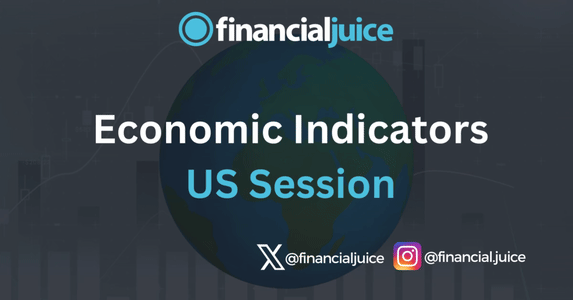
Week Ahead: Economic Indicators (US)
Hey, Traders!
For the February 26th week, here is a list of all of the major economic indicators being released during the US Session, with a brief synopsis of what they represent and what to possibly expect from the markets in reaction.
Monday 26th February
10:00 ET
US New Home Sales for January
New home sales refer to the number of newly constructed homes that have been sold during a specific time period, typically reported monthly in the United States. This data insights into the overall health of the housing market and can indicate trends in consumer confidence and economic growth.
What to Expect
Although this data is unlikely to garner a market reaction, rising sales often stimulate job creation and economic expansion, while declines may indicate broader economic challenges or shifts in market conditions.
Morgan Stanley note that the rise in single-family permits, and mortgage applications, and the increase in U of Mich. home buying conditions suggest a rise in new home sales.
Tuesday 27th February
08:30 ET
US Durable Goods January Prelim
US Durable Goods represents the change in the value of orders for durable goods from domestic manufacturers in the United States.
This economic indicator, reported by the US Census Bureau, serves as a gauge of short-term fluctuations in business investment.
Positive changes signify increasing orders, reflecting potential economic growth and heightened confidence among businesses, while negative changes may indicate declining demand or economic uncertainty.
What to Expect
Greater than expected US Durable Goods data could result in dollar strength and US stock weakness, as this suggests that demand for durable goods could be ignoring the effects of monetary policy from the Fed, and may have implications for other areas of the economy. However, if it comes in lower, that could mean, durable goods is reacting how policymakers desire.
Unicredit noted that there is no weakness evident, but the strong gains from early COVID lockdowns faded over 2023. The slower pace of orders is part of what is causing prices to moderate.
“The extremely low levels of confidence – despite reasonably healthy consumer spending – underscore the view that high prices have been a critical factor dampening confidence.” Societe Generale wrote in a note.
“The Conference Board index jumped to its highest level since December 2021. The timing of the jump is the question. Historically, the level of confidence is low and not yet back to pre-COVID levels.”
Morgan Stanley: “We expect ongoing small increases in underlying orders and shipments – neither acceleration nor deceleration.”
10:00 ET
US Conference Board Consumer Confidence for February
US Consumer Confidence measures the optimism or pessimism among consumers about the overall economic conditions and their personal financial situations.
Compiled and released by the Conference Board through consumer surveys, the index comprises two key components: the Present Situation Index, reflecting current perceptions of economic and employment conditions, and the Expectations Index, indicating consumers’ outlook for the short-term future.
A higher index generally signals increased consumer optimism, potentially leading to higher spending, while a lower index may suggest heightened pessimism and potential decreases in consumer spending.
What to Expect
Considering the current position of the US economy, traders must weigh two scenarios when assessing this data. Lower-than-expected data could indicate consumers are spending less than they otherwise would, potentially helping inflation’s downward trend.
Conversely, if sentiment turns out to be higher than expected, this may indicate that consumers are content about the financial climate, which could aid a soft landing.
Wednesday 28th February
08:30 ET
US GDP Q4 Second Estimate
US GDP refers to the Gross Domestic Product.
GDP is a key indicator of the economic health and performance of a country and represents the total value of all goods and services produced within the country’s borders during a specific period.
The fourth-quarter GDP figure provides insights into the growth rate or contraction of the economy during the final three months of the year.
It’s an essential data point for policymakers, economists, and investors, offering information on overall economic activity, consumption, investment, government spending, and net exports.
What to Expect
Although a strong GDP figure will help cement a soft landing it could also have negative implications for monetary policy. Market participants will need to balance out these risks when assessing what this data means for US stocks and the dollar.
“We expect real growth to be trimmed by 0.2 percentage points to a 3.1% annual rate. The slower pace reflects the downward revisions to November and December retail sales.” Morgan Stanley wrote in a note.
10:30 ET
Weekly EIA Crude Oil Inventories
The US Weekly Energy Information Administration Crude Oil Inventories report provides information on the total stockpile of crude oil in the United States.
It includes data on the changes in crude oil inventories, indicating whether there has been an increase or decrease in the amount of oil held in storage.
This report assesses supply and demand dynamics in the oil market and can influence oil prices.
What to Expect
A significant buildup in inventories may indicate oversupply, putting downward pressure on prices, while a decline may suggest increased demand, potentially impacting prices in the opposite direction.
Thursday 29th February
08:30 ET
US PCE Price Index for January
The US Personal Consumption Expenditures Price Index is a measure of inflation that tracks changes in the prices of goods and services purchased by consumers throughout the US.
It is released monthly by the Bureau of Economic Analysis and is considered a key indicator of inflationary trends.
The PCE Price Index is closely watched by policymakers at the Federal Reserve, as it helps them assess whether inflation is rising or falling relative to their target.
Unlike other measures of inflation, such as the Consumer Price Index (CPI), the PCE Price Index includes data on personal consumption expenditures, which covers a broader range of goods and services and is based on more comprehensive data sources.
The basket of goods measured in the PCE report is also variable based on consumer spending habits, making it a better representation of how much more consumers are actually spending on their shopping and services.
What to Expect
Higher-than-expected inflation indicates that the Fed may need to keep rates higher for longer to bring inflation sustainably back to its 2% target, which would be likely to cause markets to pull back their bets on Fed rate cuts this year. This would cause strength in US dollar, and weakness in the stocks.
Unicredit wrote in a note that they think the acceleration seen last month is mostly due to monthly volatility and one-offs.
“We are expecting the PCE to be more elevated versus recent months as well. Not only were the CPI components that feed directly into the PCE up, but healthcare costs and financial costs available in the PPI were also up.” noted Societe Generale.
US Weekly Initial & Continued Jobless Claims
The US Initial Jobless Claims report provides data on the number of individuals who filed for unemployment benefits for the first time during the previous week.
It serves as an indicator of the labor market’s health, with higher numbers indicating increased layoffs and economic instability, while lower numbers suggest a stronger job market.
Continued Jobless Claims, on the other hand, represent the number of individuals who remain on unemployment benefits after their initial claim.
What to Expect
Employment is one of the Fed’s mandates, however, FOMC officials have mentioned that they do see a higher unemployment rate being in line with their goal back to 2% inflation.
This means that Jobless Claims coming in higher than expected, suggesting higher unemployment, would be likely to be read by the Fed as good news for inflation’s return to target.
This scenario could cause US stocks to strengthen and the dollar to weaken.
Friday 1st March
09:45 ET
US S&P Manufacturing PMI February Final
The US S&P Manufacturing Purchasing Managers’ Index is an economic indicator that measures the performance of the manufacturing sector.
It provides insight into factors such as new orders, production levels, employment, supplier deliveries, and inventory levels.
As a diffusion index, a reading above 50 indicates expansion in the sector, while a reading below 50 suggests contraction. The S&P Manufacturing PMI is based on a survey of purchasing managers in the manufacturing industry.
What to Expect
The markets still seem to think that ‘good news is bad news’ with this report, though it has less weight than its counterpart (The ISM Manufacturing PMI, detailed below)
Nonetheless, this means that if the manufacturing PMI comes in above expectations, especially in expansionary territory (50+), then stocks are likely to weaken, and the dollar is likely to strengthen.
This is because it is seen as an upside inflation risk, as it indicates there is still strong demand for manufactured goods, despite high interest rates.
Morgan Stanley note that the 0.8 point rise in the S&P manufacturing index to 51.5 in February (P) was broad-based, with increases in indexes of output, new orders, and employment from levels already above 50, along with improved supplier deliveries. The overall index was at its highest since September 2022.
10:00 ET
US ISM Manufacturing PMI for February
The US ISM Manufacturing Purchasing Managers’ Index measures the economic activity and sentiment of manufacturing sector managers.
It assesses factors like new orders, production, employment, supplier deliveries, and inventories.
The index is compiled from a survey of purchasing managers as a diffusion index, with a reading above 50 indicating expansion and below 50 indicating contraction.
The US S&P Manufacturing PMI also measures manufacturing sector activity but uses a different methodology and survey structure. While both PMIs aim to gauge the health of the manufacturing sector, they may differ in their coverage, sample size, and methodology, leading to variations in the reported figures.
What to Expect
The markets still seem to think that ‘good news is bad news’ with this report.
This means that if the manufacturing PMI comes in above expectations, especially in expansionary territory (50+), then stocks are likely to weaken, and the dollar is likely to strengthen.
This is because it is seen as an upside inflation risk, as it indicates there is still strong demand for manufactured goods, despite high interest rates.
“The sector faces ongoing headwinds from high-interest rates, heightened economic uncertainty and expenditure switching towards services.” Unicredit noted.
“Supply-chain disruption in the Red Sea may show up as a lengthening of suppliers’ delivery times and higher input price pressures.”
Societe Generale noted that they look for a decline in the orders component, offset by gains throughout the other components.
University of Michigan Sentiment February Final
The University of Michigan Consumer Sentiment Index, often referred to as the Consumer Sentiment Index or just Consumer Sentiment, is a widely followed economic indicator that measures the confidence of American consumers in the state of the economy.
It is based on a survey conducted by the University of Michigan, which gathers data on consumers’ attitudes and expectations regarding their personal finances, business conditions, and overall economic outlook.
The index is released monthly and is considered a leading indicator of consumer spending, as confident consumers are more likely to spend money on goods and services, driving economic growth.
What to Expect
Consumer sentiment is closely watched by markets to assess consumer resilience in a high-interest-rate environment. Elevated sentiment may suggest strong demand, potentially leading to inflationary pressures, but it could also signal consumer resilience, reducing recession fears.
In this release, the market focus is on the 1 & 5-year inflation expectations accompanying the sentiment data.
Higher inflation expectations may delay Fed rate cuts, affecting US stocks negatively and strengthening the dollar.




